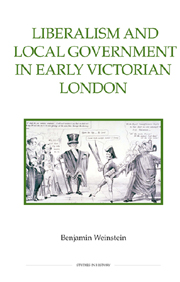Book contents
- Frontmatter
- Contents
- Acknowledgements
- Abbreviations
- Introduction
- 1 Liberal attachments to the unreformed metropolis
- 2 The ‘radicalisation’ of metropolitan political culture, 1832–1841
- 3 The polarisation of metropolitan political culture, 1842–1855
- 4 Redefining the state, I: Rates and taxes, 1834–1853
- 5 Redefining the state, II: The London government problem
- 6 Marylebone in 1854: from conflict to compromise
- Conclusion
- Bibliography
- Index
6 - Marylebone in 1854: from conflict to compromise
Published online by Cambridge University Press: 12 September 2012
- Frontmatter
- Contents
- Acknowledgements
- Abbreviations
- Introduction
- 1 Liberal attachments to the unreformed metropolis
- 2 The ‘radicalisation’ of metropolitan political culture, 1832–1841
- 3 The polarisation of metropolitan political culture, 1842–1855
- 4 Redefining the state, I: Rates and taxes, 1834–1853
- 5 Redefining the state, II: The London government problem
- 6 Marylebone in 1854: from conflict to compromise
- Conclusion
- Bibliography
- Index
Summary
Preceding chapters have emphasised the centrality of conflict to London's liberal political culture. It has been argued that discrete liberal subgroups, which subscribed to incompatible and in many ways antagonistic sets of political priorities, emerged within the reformed metropolitan constituencies during the mid-1830s and immediately began to compete with one another for political supremacy. This competition was intensified, or at the very least reinforced, by the cultural fault-lines which lay between these groups. Whereas the input of London's ‘shopocracy’ tied vestry radicalism to the related causes of government retrenchment and ratepayer self-determination, the cultural orientations of London's large professional community ensured a fairly substantial support base for the paternalist reform programme offered by Russellite Whiggery. Moreover, professionals by and large rejected market-driven and retrenchment-minded liberalism in favour of a bureaucracy of ‘experts’ which might protect London's poorest and most vulnerable from the self-interested parsimony of the ratepayers. London's paternally-minded social elites, of which there were many, joined the professionals in rejecting ratepayer democracy – many doing so out of the associated realisation that ‘government by experts’ would also protect the metropolitan landlords from the myopic parsimony of the ratepaying leaseholders and tenants. At the same time as London's professionals were hitching their star to Whiggery, the vestry camp was beginning to find its own parliamentary voice through an increasingly close association with populist ‘titled radicals’ such as Thomas Duncombe and Charles Tennyson D'Eyncourt. The speed with which many of London's socially Whiggish ‘titled radicals’ defected into the ultra-radical vestry camp during the mid- and late 1830s exacerbated the divisiveness of London's liberal political culture and eventually precipitated a polarisation of metropolitan liberalism during the 1840s and '50s.
- Type
- Chapter
- Information
- Liberalism and Local Government in Early Victorian London , pp. 145 - 166Publisher: Boydell & BrewerPrint publication year: 2011

